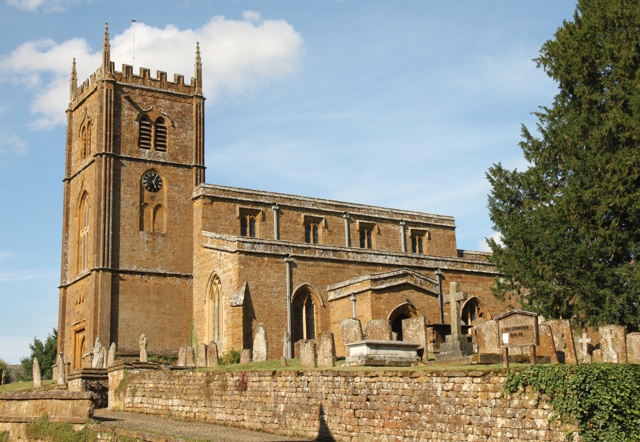


























All Saints Church, Wroxton
All Saints Church in Wroxton, consists of nave, chancel, north and south aisles, south porch, and western tower. Structurally there is no sign of anything earlier than the 14th century, when the whole fabric appears to have been refashioned or altogether rebuilt. In the 15th century the clerestory was added to the nave, and the nave aisles were given wooden roofs, substantial portions of which still survive. Traces of a medieval wall painting remain above the chancel screen. Some work must have been done on the tower in the early 17th century, to judge by a stone dated 1636 on the inside wall, but by 1748 it was in a perilous condition. With the assistance and encouragement of Lord Guilford, Sanderson Miller was employed to design a new tower. The work was carried out by his mason William Hitchcox of Ratley (Warws.) and the foundation stone was laid in April 1748. The tower was originally crowned with an 'octagon of stone', the squinches for which are still visible beneath the present roof. This octagon blew down almost as soon as it was erected, much to Horace Walpole's satisfaction. A gallery had been added at the west end of the church in 1738 by J. Banister; in 1755 the chancel roof was repaired and the open medieval interior ceiled; and between 1738 and 1823 the church was re-pewed. In 1823 it was recorded that an annual income of £24 was used for painting the pews and that the church was in an excellent state of repair. In 1845–6 the font was entirely recarved and the church was re-seated; an organ (by Halmshaw & Sons) was erected in the west gallery in 1879 and new heating apparatus and electric light were installed in 1932 and 1936. In 1885 Colonel North gave stained glass panels of the twelve apostles by Clayton & Bell in the chancel, and in 1884 and 1894 the windows by Burlison and Grylls at the east end of the north and south aisles. During the late 19th century Colonel North made extensive purchases of 16th- and 17th-century continental carved woodwork from different countries. These, some of which are very fine, are to be found let into the pulpit, on the back of the chancel screen, which mostly dates from the 15th century, on the front of the chancel pews, and as a frieze behind the altar at the east end of the chancel. The church contains some notable monuments. In the chancel is a huge canopied tomb to Sir William Pope, Earl of Downe (d. 1631), and his wife Anne (d. 1625), with kneeling children. Among other monuments the most noteworthy are an elegant wall slab to Lord North, the Prime Minister, (d. 1792) carved by John Flaxman in 1800, and another to the three wives of Francis, Lord Guilford (d. 1790), by Joseph Wilton (1783). There are grave stones to Sir Thomas Pope, Earl of Downe (d. 1668), and to Francis, Lord Guilford (d. 1685), Lord Keeper. Among the local gentry and their wives who are commemorated are Thomas Sacheverell (d. 1675), son of the Rector of Tadmarton, Robert Burden of Balscott (d. 1677), and John Burden (d. 1687). Among the brasses in the chancel is one to Margaret Bustard (d. 1557), wife first of William Pope of Deddington and then of John Bustard of Adderbury, and mother of Sir Thomas Pope, founder of Trinity College, Oxford. There are 5 bells, all cast by Henry Bagley in 1676. The plate includes a silver paten given by the Hon. Mrs. Ann North in 1722, and bought back by Lord North after its sale with other surplus communion plate by the vicar and parishioners in 1885. In 1805 c. 8 a. in lieu of open-field land were allotted to the churchwardens for church repairs; in 1823 the rent was as much as £24 a year. In the period 1941–c. 1955 the land was leased for mining and the royalties were spent mostly on reducing a debt of over £5,000 incurred in church restoration. In 1902 Henry Fox vested Ragnell's Close (5 a.) in the vicar and churchwardens for the maintenance of the church clock and the upkeep of the churchyard. In the period 1941–c. 1955 the land was leased for mining, and in 1960, Trinity College were renting it for £189. Historical information about All Saints Church is provided by 'Parishes: Wroxton', in A History of the County of Oxford: Volume 9, Bloxham Hundred, ed. Mary D Lobel and Alan Crossley (London, 1969), pp. 171-188. British History Online http://www.british-history.ac.uk/vch/oxon/vol9/pp171-188 [accessed 23 February 2023]. All Saints Church is a Grade II* listed building. For more information about the listing see CHURCH OF ALL SAINTS, Wroxton - 1300046 | Historic England. For more information about All Saints Church see Parishes: Wroxton | British History Online (british-history.ac.uk). |

